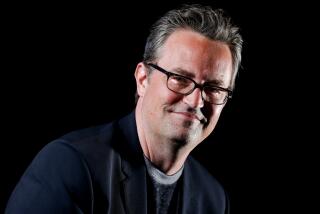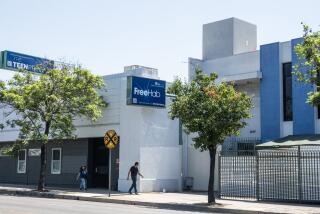A Guru’s Fall From Grace
SAN FRANCISCO — He was a junkie and a child alcoholic--but he whipped his problems, then set about helping other addicts do the same. With charm and a brash wit, he built a drug rehabilitation program that brought him celebrity status and a hero’s image. Then, suddenly, the booze was back. Now, John Maher is determined to stay sober--and trying to rebuild his life.
The people who still care about John Maher remember him as a man with sparkling blue eyes and a special Irish gift for gab, a former heroin addict from New York who turned his own life around and then inspired hundreds of others to do the same.
The founder of a drug rehabilitation program called the Delancey Street Foundation, Maher conquered and charmed this city with a comic wit and a tough-talking mix of swagger and compassion that made him seem half hoodlum and half saint.
Maher’s solution to drug addiction was to toughen addicts emotionally and put them to work helping others. To that end, Delancey Street became the ally of the poor and the weak and every underdog in San Francisco, a colorful part of the city’s social and political fabric.
Delancey’s Street’s founder, a genius for publicity, was a media celebrity--the subject of two books, a television movie, a “60 Minutes” segment and dozens of adoring articles in newspapers and magazines.
Word Spread
And then, just as suddenly as he had become a part of the San Francisco scene, Maher disappeared. The word spread slowly that Maher and Delancey Street had parted company, but the reason remained a well-kept secret for more than three years.
Maher, a child alcoholic before he discovered heroin, had started drinking again. A series of drunken escapades, including a drunk-driving incident on the Oakland Bay Bridge, forced the final separation.
In Maher’s absence, Delancey Street continued under the direction of Mimi Silbert, a criminologist and psychologist who served as Maher’s co-president for years. Maher and Silbert had lived together for more than a decade, and Maher had helped raise Silbert’s two teen-age sons.
Delancey Street’s closest supporters initially feared a deluge of negative publicity over Maher’s personal troubles. But most of the press had no idea of what had happened. Those in San Francisco who knew about the drinking chose not to make it public.
As time passed, the fears subsided. Delancey Street not only survived but flourished. Slowly, Maher became an almost forgotten man. Callers to Delancey Street were told simply that he was no longer with the organization. Increasingly, there was no mention of his name in references to Delancey Street’s early history.
Thousands of miles away from San Francisco, Maher was on his own, fighting to survive.
A heavy rain had already turned the housing site on New York City’s Roosevelt Island into a pool of mud and blotted out the Manhattan skyline on the far shore of the East River. Now a snowstorm was beginning as Maher sat in the small construction trailer and talked about his downfall.
“I was in terrible trouble,” he said. “I had a breakdown for a couple of years, but I’m in much better shape than I was. I haven’t had a drink in the last four months.
“Now, I’m your normal, average scum trying to get through. I always say I’m like the Titanic, found but not surfaced.”
Maher, 47, blamed the start of his drinking on personal problems. For most of 1984, only Silbert had known about the situation and had tried to solve things on her own. Finally, she and Maher went to a small group of senior Delancey Street residents and supporters. Maher offered to resign, but the group gave him a chance to sober up with the foundation’s help.
The drinking continued, however. On the night of Jan. 11, 1985, while heading toward San Francisco from Oakland, Maher’s car smashed into another at the Bay Bridge toll plaza. After failing a sobriety test, Maher was arrested and jailed for drunk driving. A Breathalyzer test showed Maher’s blood alcohol level as .20, twice the level needed to sustain a drunk-driving charge.
Maher pleaded guilty. He was fined $664, his driver’s license was suspended for three months and he was placed on probation for three years. He was also sent by Delancey Street to a remote ranch facility operated by the group in Santa Fe, N.M., where it was hoped that he might still respond to Delancey Street’s traditional “tough love” approach to therapy.
According to both Maher and others, however, Santa Fe turned into just one more disaster, and this time Maher showed up drunk in front of Delancey Street residents. By now, Delancey Street had accepted Maher’s resignation, but was still committed to trying to help him. Stays in a private treatment program in West Sedona, Ariz., and another Delancey Street facility in Brewster, N.Y., followed.
Still drinking, he moved into a Manhattan apartment, continuing to struggle with his drinking problem, as well as deteriorating health that led, according to Maher, to a series of heart attacks.
Drinking Progressed
Maher moved out of his first apartment as his drinking progressed and began moving around New York, staying with friends, he said. Most recently, he added, he has been living with a friend in suburban Rockland County outside New York City but occasionally sleeps in the small construction trailer on Roosevelt Island, where he has been working for the last few months.
As Maher spoke, he repeatedly reached for a cigarette from a dwindling pack of Marlboro Lights. He appeared at least 40 pounds overweight, and his face had a puffy, beaten look.
Maher appeared bitter that some of his closest old friends in San Francisco have urged him to stay away from the city for at least a year until he can demonstrate that he is capable of remaining sober. At the same time, he is grateful that organized labor connections in New York got him his present job with the Operating Engineers Local 14, which runs the heavy machinery at construction sites.
“I had great difficulty in getting employment because I had never worked before,” Maher said. “I was a heart patient with no job history and no credit outside Delancey Street. So I had to start a new life. . . . For me, it’s a way to make a living and get back on my feet.”
Ultimately, Maher said, he “would love” to return to Delancey Street or to some kind of job in San Francisco involved with social and political issues. As he spoke about his hopes, a little of the old brashness crept into his voice.
‘Larger Stage’
“Any of us can go down the tubes if we don’t lead ethical lives. I said it many times and it’s true,” Maher said. “I miss Delancey Street and the excitement of playing on a larger stage. I would prefer to see it done a little differently, but it is clearly still the most effective, best place for an addict or an ex-con to rehabilitate himself or herself and build a new life
“For the moment, you could say I’ve become a hero of the working class,” Maher added. “Ultimately, I will go back to San Francisco to some job in the political realm, anything that pays enough to live and provides some sort of ethical thing for the white hats to fight for.
“That’s really the only thing I can do. It’s a limited market for aging gurus.”
Silbert’s ordeal, according to friends, was as difficult in many ways as Maher’s painful downfall. Not only was she struggling with the breakup of their relationship and the impact of Maher’s drinking on her children, she was working around the clock to stave off an unprecedented crisis for Delancey Street.
Silbert’s romance with Maher had seemed to many a classic love story. At one point, Jane Fonda, a friend of both Silbert and Maher, had contemplated producing a movie about the pair. There was talk of Fonda playing Silbert and possibly Jon Voight starring as Maher.
The only key member of Delancey Street’s hierarchy who never had a drinking or drug problem of her own, Silbert was a graduate of UC Berkeley and a former student of philosophy under Jean-Paul Sartre in Paris. She currently is a member of the California Board of Corrections.
“I think I’m the only person who has come to Delancey Street who has led a straight and decent life who is proud of it,” she said once. “I think it’s despicable that so many Americans feel compelled to pour out their flaws. People seem almost obliged to tell others how bad they are.”
Guiding Force
While Maher was the guiding force behind Delancey Street in the early 1970s, many of the group’s top supporters say Silbert had the main responsibility for actually running the organization in the years before Maher’s drinking surfaced.
Maher was increasingly less involved with the operations of Delancey Street and more interested in outside politics, particularly the Irish movement to obtain the independence of Northern Ireland from Great Britain, his former supporters say.
“What John did best was the public kind of speaking and rally. Mimi was the one who refined everything and made Delancey Street into a place that actually worked,” said JoAnn Mancuso, 39, a Delancey Street resident since 1971.
The impact of Maher’s departure on most Delancey Street residents was minimal because they had so little contact with him, Mancuso said.
“Mimi held a meeting with the residents at the clubhouse,” she said. “I’m not sure they quite understood what it meant to them. I think they felt sad that we all looked sad. It was not something that was affecting them personally.”
Among Delancey Street’s most senior residents, however, Maher’s drinking triggered a much stronger response.
‘Went Through Hell’
“I think most of us were really angry and outraged,” said Abe Irizarry, 44, a Delancey Street resident since 1973 and now one of the organization’s two vice presidents. “Mimi went through hell. She was torn over the loss of the man she loved and trying to hold Delancey Street up. I don’t know how she did it, frankly. She’s just a very classy lady.”
After Maher’s ouster, Silbert threw her energies into the most ambitious building project in the organization’s history: a $30-million apartment and retail shopping complex called the Embarcadero Triangle in the South Beach section of the San Francisco waterfront.
Ground-breaking for the 400,000-square-foot complex, which will house up to 600 people in 177 apartment units, was in November, and the project is scheduled to be completed late next year, subject to some remaining financing arrangements.
“This is a do-or-die project for us,” Silbert said last week in an interview at Delancey Street’s current headquarters, a Pacific Heights mansion that once housed the Soviet Consulate in San Francisco. “Everything we have is riding on it.”
Delancey Street’s population has doubled in the last few years to more than 600 residents in facilities in San Francisco, Santa Monica, New York, Santa Fe and Greensboro, N.C., Silbert said. The new construction project, she added, is needed to provide space for further growth.
Silbert would not talk publicly about Maher. But others said she has made it clear that she hopes he will stay away from the city until he can demonstrate that he has come to grips with his problems.
Former Friends
Many of Delancey Street’s top supporters and Maher’s closest former friends share Silbert’s concerns, as well as grief, over Maher’s decline.
“I hate the guy for what he’s done to himself,” said Dugald Stermer, a San Francisco artist who was one of Maher’s closest friends. “John had the world. He had mayors and presidents calling him up. I met Jimmy Carter in his office.
“And he had the best friends in the world. And he had Mimi. And he chooses vodka and orange juice over everything.
“Every day I expect to hear he’s died,” Stermer said.
Maher’s younger brother, San Francisco Supervisor Bill Maher, himself a former Delancey Street resident and reformed drug addict, takes a more optimistic view.
“John is a wonderful man in terrible shape at the moment,” Bill Maher said. “The problem with John is that he and Chuck Dederich (the founder of Synanon) wrote the book on curing addicts. If you know every scam and trick in the book, it can be harder on you finding something that will work.
“I haven’t given up on John,” he added. “My brother is my hero.”
Today we’ve got this view that people are only human when they act like utter fools. What’s human is what’s highest in us. It’s not what’s lowest or what’s weakest. --John Maher, 1977
More to Read
Sign up for Essential California
The most important California stories and recommendations in your inbox every morning.
You may occasionally receive promotional content from the Los Angeles Times.









